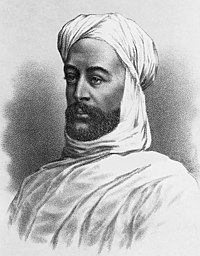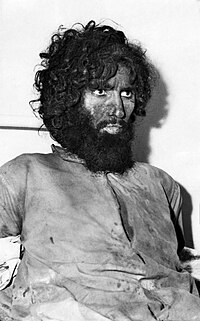| Part of a series on |
| Islam |
|---|
 |
People claiming to be the Mahdi have appeared across the Muslim world - in South Asia, Africa and the Middle East - and throughout history since the birth of Islam (610 CE).
In Shia and Sunni eschatology, the Mahdi is a Messianic figure who, it is believed, will appear on Earth before the Day of Judgment and, alongside Jesus, will rid the world of wrongdoing, injustice and tyranny
A claimant Mahdi can wield great temporal, as well as spiritual, power: claimant Mahdis have founded states (e.g. the late nineteenth-century Mahdiyah in Sudan), as well as religions and sects (e.g. Bábism, or the Ahmadiyya movement).
The continued relevance of the Mahdi doctrine in the Muslim world was most recently emphasised during the 1979 seizing of the Grand Mosque in Mecca, Saudi Arabia, by at least 200 militants led by Juhayman al-Otaibi, who had declared his brother-in-law, Muhammad bin abd Allah al-Qahtani, the Mahdi.
Seventh century
- The first historical reference to a movement using the name of Mahdi is al-Mukhtar's rebellion against the Umayyad caliphate in 686 CE, almost 50 years after Muhammad's death. Al-Mukhtar claimed that Muhammad ibn al-Hanafiyyah, a son of the fourth caliph and first Shia imam, Ali, was the Mahdi and would save the Muslim people from the rule of the Umayyads. Ibn al-Hanifiyyah himself was not actively involved in the rebellion, and when the Umayyads successfully quashed it, they left him undisturbed.
Eighth century
Salih ibn Tarif
Salih ibn Tarif, the second king of the Berghouata, proclaimed himself prophet of a new religion in the eighth century. He appeared during the caliphate of the Ummayad Hisham ibn Abd al-Malik. According to Ibn Khaldun's sources, he claimed receiving a new revelation from God called a Qur'an, written in the Berber language with 80 chapters. He established laws for his people, which called him Salih al-Mu'minin ('Restorer of the Believers'), and the final Mahdi.
Islamic literature considers his belief heretical, as several tenets of his teaching contrast with orthodox Islam, such as capital punishment for theft, unlimited wives, unlimited divorces, fasting of the month of Rajab instead of Ramadan, and ten obligatory daily prayers instead of five. Politically, its motivation was presumably to establish their independence from the Umayyads, establishing an independent ideology lending legitimacy to the state. Some modern Berber activists regard him as a hero for his resistance to Arab conquest and his foundation of the Berghouata state.
Ninth century
Muhammad ibn Ja'far al-Sadiq
Muhammad ibn Ja'far al-Sadiq (d. c. 818 CE), appeared in Mecca in AH 200 / 815 CE, claiming to be the Mahdi.
Muhammad ibn Hasan ibn Ali
Muhammad ibn Hasan ibn Ali (29 July 869 - ?), more commonly called Muhammad al-Mahdi, is the twelfth imam of Twelver Shia Islam and believed by Twelver Shia Muslims to be in occultation, from which state he will return in the traditional form of the Mahdi.
Tenth century
Ubayd Allah al-Mahdi Billah
Ubayd Allah al-Mahdi Billah (r. 909-934), the first caliph of the Fatimid state, established in 909, was one of only two claimants who succeeded in establishing a state. (See Muhammad Ahmad below).
His Da'i Abu 'Abdullah Al-Husayn Al-Shi'i helped secure for him parts of north Africa using the support of the Berber locals. The Fatimids later built Cairo as capital in Egypt and their descendants continued to rule as Caliphs (the sixth, Al-Hakim bi-Amr Allah, is believed by the Druze to be in occultation and due to return as Mahdi on Judgment Day) until Saladin took over Egypt and canceled the Fatimid state. He imprisoned the last Fatimid Caliph and his family in the Fatimid Palace until death.
Twelfth century
Ibn Tumart
The Moroccan Ibn Tumart (c. 1080 - c. 1130), sought to reform Almoravid decadence in the early 12th century. Rejected in Marrakech and other cities, he turned to his Masmuda tribe in the Atlas Mountains for support. Because of their emphasis on the unity of God, his followers were known as Al Muwahhidun ('unitarians', in western language: Almohads).
Although declaring himself mahdi, imam and masum (literally in Arabic: innocent or free of sin), Muhammad ibn Abdallah ibn Tumart consulted with a council of ten of his oldest disciples, and conform traditional Berber representative government, later added an assembly of fifty tribal leaders. The Almohad rebellion began in 1125 with attacks on Moroccan cities, including Sus and Marrakech. But as Muhammad ibn Abdallah ibn Tumart died in 1130, his successor Abd al Mumin took the title of Caliph -claiming universal leadership in Islam- and placed members of his own family in power, converting the system into a traditional sultanate.
Fifteenth century
Muhammad Jaunpuri
Muhammad Jaunpuri[1] (9 September 1443 - 23 April 1505), born in northeastern India in Jaunpur (modern-day Uttar Pradesh), was a descendant of Muhammad's grandson, Husayn ibn Ali (626-01-08 - 680-10-10) through the seventh imam, Musa Kadhim (745-11-06 - 799-09-01).
He claimed to be the Mahdi on three occasions, first in Mecca, and later twice in India, attracting a large following, and opposition from the ulema.
His five deputies were Sani Mahdi, Shah Dilawar, Shah Khundmir, Shah Neymath and Shah Nizam.
Muhammad Jaunpuri died in 1505, aged 63, at Farah, Afghanistan. His followers, known as Mahdavis, continue to exist and are centred around the Indian city of Hyderabad, although there Mahdavi communities in Gujarat, Karnataka and Maharashtra, as well as in Pakistan and overseas in America and Britain.[1]
Nineteenth century

The nineteenth century provided several Mahdi claimants, some of whose followers and teachings survive to the present day.
Diponegoro
Prince Diponegoro (11 November 1785 – 8 January 1855), Javanese son of the Sultan of Yogyakarta. He saw himself as the Ratu Adil (as prophesised by King Joyoboyo), a Javanese equivalent of the Mahdi, to fight against Dutch colonialism. Now a National Hero in Indonesia.
Alí Muḥammad Shírází (Báb)
Alí Muḥammad Shírází (20 October 1819–9 July 1850), claimed to be the Mahdi on 24 May 1844, taking the name Báb (Arabic: باب / English: Gate) and thereby founding the religion of Bábism. He was later executed by firing squad in the town of Tabriz. His remains are currently kept in a tomb at the Bahá'í World Centre in Haifa, Israel.
The Báb is considered the forerunner of Bahá'u'lláh (pronounced ba-haa-ol-laa / Arabic: بهاء الله / English: Glory of God), and both are considered prophets of the Bahá'í Faith. The declaration by the Báb to be the Mahdi is considered by Baha'is to be the beginning of the Bahá'í calendar.[2]

Muhammad Ahmad
Muhammad Ahmad (12 August 1844-22 June 1885), a Sudanese sufi sheikh of the Samaniyya order, declared himself Mahdi in June 1881 and went on to lead a successful military campaign against the Turko-Egyptian government of Sudan. Although he died shortly after capturing the Sudanese capital, Khartoum (1885), the Mahdist state continued under his successor, Abdallahi ibn Muhammad, until 1898, when it fell to the British army following the Battle of Omdurman.

Mirza Ghulam Ahmad
Mirza Ghulam Ahmad (13 February 1835-26 May 1908), claimed to be both the Mahdi and the second coming of Jesus in the late nineteenth century in British India. He founded the Ahmadiyya religious movement in 1889, which, although considered by its followers to be Islam in its pure form, is not recognized as such by the majority of mainstream Muslims. In 1974, the Pakistani parliament adopted a law declaring the Ahmadis to be non-Muslims. Since Ghulam Ahmad's death, the Ahmadiyya community has been led by his successors and has grown considerably.[3]
Twentieth century
Ariffin Mohamed
Ariffin Mohamed (1943 - ), also known as "Ayah Pin", the leader and founder of the banned Sky Kingdom, he was born in 1943 in Beris, Kampung Besar Bachok, Kelantan. In 1975 a spiritual group was formed in Bagan Lebai Tahir, Butterworth, Penang. He claimed to be the incarnation of Jesus, as well as Muhammad, Shiva, and Buddha|Buddha]]. Devotees of Sky Kingdom believe that one day, Ayah Pin will return as the Mahdi. His followers consider him the king of the sky, and the supreme object of devotion for all religions.[4]

Muhammad bin abd Allah al-Qahtani
Muhammad bin abd Allah al-Qahtani (28 September 1935 - 9 January 1980), was proclaimed Mahdi by his brother-in-law, Juhayman al-Otaibi, who led over 200 militants to seize the Grand Mosque in Mecca on 20 November 1979. The uprising was defeated after a two-week siege in which at least 300 people were killed.
Twenty First century
Dia Abdul Zahra Kadim
Dia Abdul Zahra Kadim (1970 - 29 January 2007), a Shia Iraqi former leader of Soldiers of Heaven, claimed to be the Mahdi.
A number of people have been claimed to be the Mahdi by their followers or supporters
- Muhammad ibn Abdallah An-Nafs Az-Zakiyya
- Muhammad ibn Abdullah al-Aftah ibn Ja'far al-Sadiq
- Ja'far al-Sadiq (according to the Tawussite Shia)
- Musa al-Kadhim (according to the Waqifite Shia)
- Muhammad ibn Qasim (al-Alawi)
- Yahya ibn Umar
- Muhammad ibn Ali al-Hadi
- Riaz Ahmed Gohar Shahi (according to Messiah Foundation International)
See also
- False messiah
- Jewish Messiah claimants
- List of avatar claimants
- List of Buddha claimants
- List of messiah claimants
- List of people who have claimed to be Jesus
- List of people who have been considered deities
- Messiah
- Messiah complex
Notes
- ^ a b Biography - Promised One, a biography of Syed Muhammad Jaunpuri
- ^ Smith, P. (1999). A Concise Encyclopedia of the Bahá'í Faith. Oxford, UK: Oneworld Publications. pp. 55–59 & 229–230. ISBN 1851681841.
- ^ http://www.alislam.org/topics/khilafat/khilafat-news-coverage.pdf
- ^ "Escape from Islam", Weekend Standard, April 23–24, 2005
References
- Yohanan Friedmann, "Prophecy Continuous - Aspects of Ahmadi Religious Thought and Its Medieval Background"; Oxford University Press (2003) ISBN 965264014X
- Timothy Furnish, "Holiest Wars: Islamic Mahdis, their Jihads and Osama bin Laden" (Greenwood, 2005)
- Peter Smith, the Bábí and Bahá'í Religions - from messianic Shi'ism to a world religion; Cambridge University Press (1987); ISBN 0-521-30128-9
- Abbas Amanat, Resurrection and Renewal - the Making of the Bábí Movement in Iran 1844-1850; Cornell University Press (1989); ISBN 0-8014-2098-9
- Esslemont, J.E. (1980). Bahá'u'lláh and the New Era, An Introduction to the Bahá'í Faith (5th edition ed.). Bahá'í Publishing Trust, Wilmette, Illinois, USA. ISBN 0877431604.
((cite book)):|edition=has extra text (help)